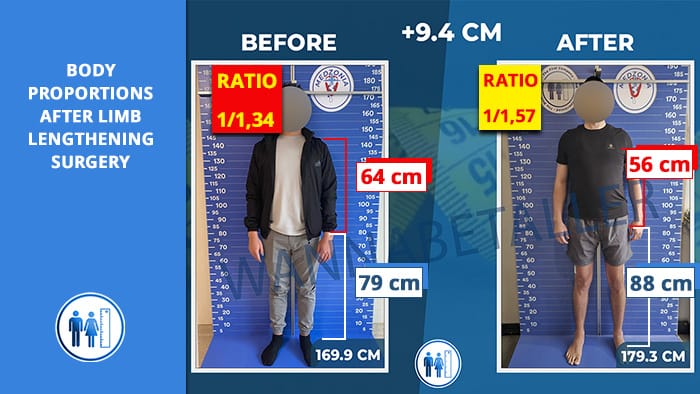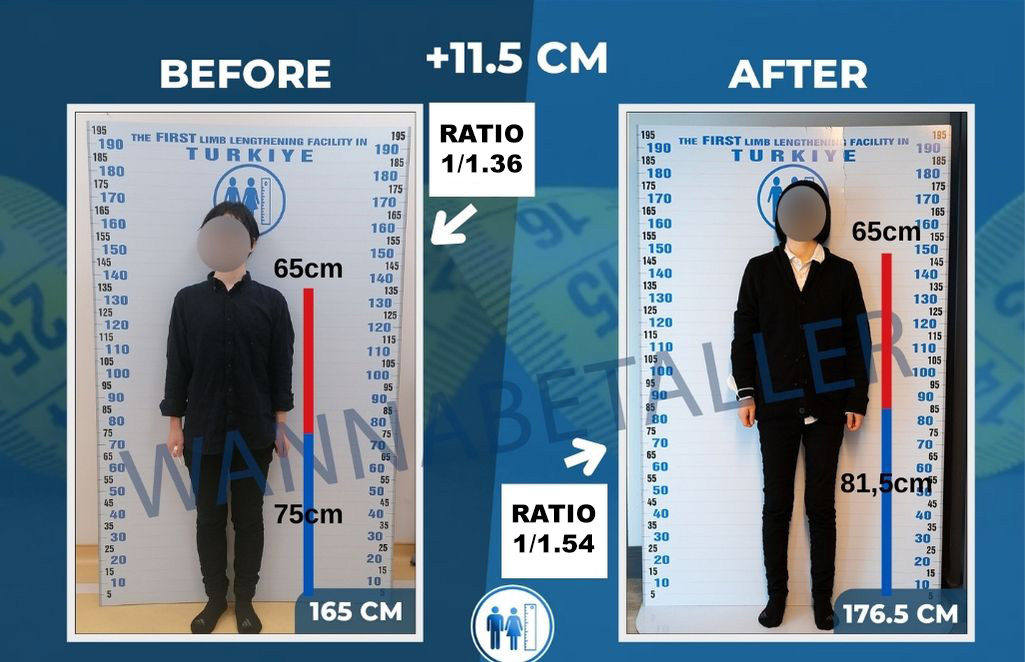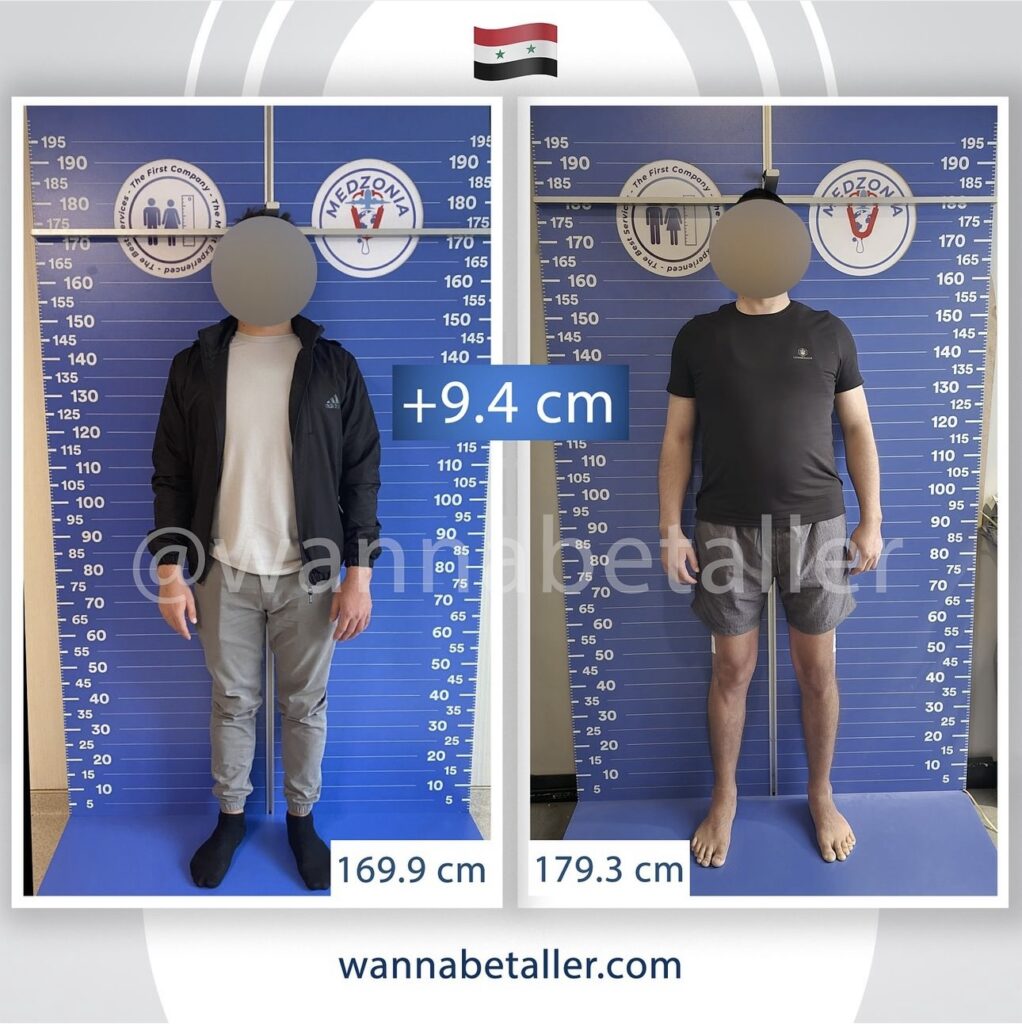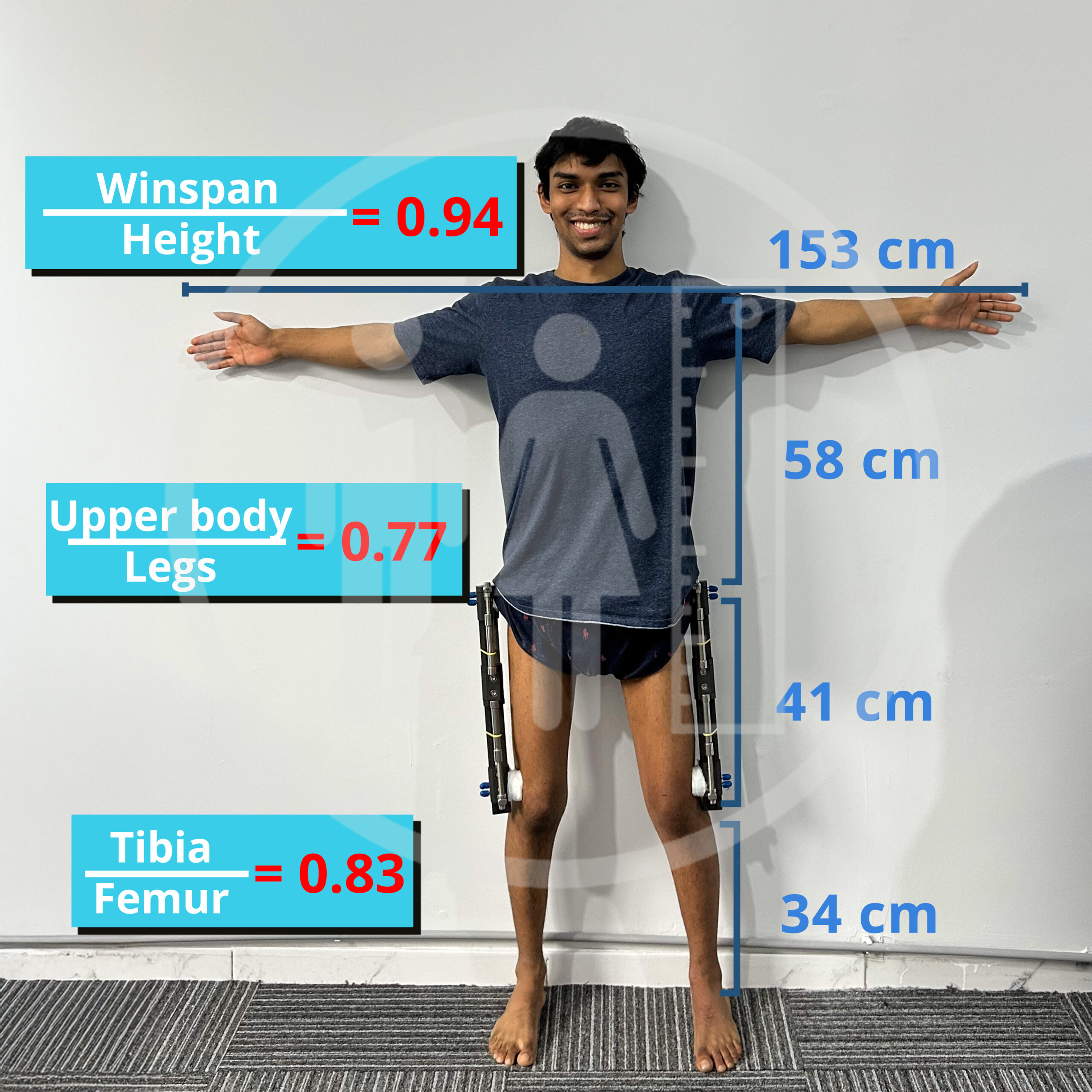The Importance of Proportion (Body Ratios) in Cosmetic Limb-Lengthening Surgery and the Golden Ratio
Limb-lengthening surgery is an aesthetic procedure that changes an individual’s physical appearance and boosts self-confidence. However, focusing solely on height may lead to the neglect of body proportions. During both the pre-surgery and post-surgery processes, it is crucial to maintain proportions and achieve an aesthetically pleasing appearance by using scientific calculations. At this point, aesthetic standards such as the “golden ratio” and details like the leg-to-body ratio come into play. In the image below, you can see an example of measurements taken on our patient, illustrating how proportions are carefully planned in limb-lengthening surgery.

What is the Golden Ratio?
The golden ratio is a principle frequently used in aesthetic surgery and is considered the key to natural beauty. Paying attention to this ratio during the surgical planning ensures that the patient achieves a balanced and aesthetically pleasing appearance that aligns with their body or facial proportions. The same principle is applied with great care in limb-lengthening surgeries. During these surgeries, the golden ratio is used as a guide in the following areas:
- Body-Leg Ratio: The ideal proportion between the length of the torso and the legs is maintained.
- Leg Segments: The ratio between the lower leg (tibia) and the upper leg (femur) can be lengthened in accordance with the golden ratio, ensuring a proportional appearance.
- Symmetry Control: Achieving complete symmetry between the right and left legs is a primary goal.
What is Proportion and Why is it Important?
Proportion refers to the harmony between various parts of the body. For an aesthetically pleasing appearance, the distribution of body parts should be balanced. If this balance is not maintained during limb-lengthening surgery, it can lead to aesthetic concerns and physical mismatches. Specifically:
- Leg-to-Height Ratio: In an average adult, the length of the legs typically represents 45-48% of their total height. If this ratio is not preserved after surgery, the legs or the upper body may appear disproportionate.
- Golden Ratio: In aesthetic mathematics, a balance close to the ratio of 1.618 between body parts is considered ideal for beauty. For example, as the ratio between head length and torso length approaches this value, the appearance becomes more aesthetically pleasing.
You can view the details of the measurement process and surgical planning for limb-lengthening from our doctor, Assoc. Prof. Dr. Yunus Öç, in the video below.
Pre-Surgery Proportion Measurements
Before limb-lengthening surgery, the body proportions of each patient are carefully analyzed. During this process:
- Biometric Measurements: Limb lengths, torso length, and overall height ratios are determined.
- Digital Modeling: Digital tools that simulate the patient’s post-surgery appearance calculate proportions according to the new height.
- Golden Ratio Analysis: The amount of height increase is checked for compliance with this mathematical ratio. Our doctor, Assoc. Prof. Dr. Yunus Öç, emphasizes that a limb-to-body ratio between 0.7 and 0.9 provides the most aesthetically pleasing results in limb-lengthening surgeries. This ratio ensures a balanced and natural appearance of the body, while a lower or higher ratio can create a visual imbalance. To maintain this balance, Assoc. Prof. Dr. Yunus Öç evaluates the upper and lower leg lengths individually and creates a personalized plan for the patient. The elongation process is managed in a way that aligns with the patient’s individual proportions, aiming for natural and aesthetically satisfying results. You can watch the doctor’s insights in the video below.
What Should Be Considered to Maintain Physical Balance?
Maintaining proportions is essential not only for aesthetic reasons but also for body health. Disproportionate elongation can:
- Apply extra pressure on the spine.
- Negatively affect walking balance.
- Cause issues with muscle and tendon alignment.
To prevent these risks, post-surgery physical therapy and the proper methods during the elongation process are crucial. Experts recommend special exercise programs to ensure that muscles gain flexibility during limb-lengthening surgery.
Methods to Prevent Proportion Loss in Limb-Lengthening Surgery
- Gradual Elongation Techniques: A maximum elongation of 1 mm per day is considered ideal for allowing the body to adapt to its new length.
- Physical Therapy Support: Stretching and balance exercises are applied to prevent muscle and tendon strain during elongation.
- Regular Check-Ups: Your doctor will monitor whether the body proportions are being maintained during the elongation process and revise the plan if necessary.

Post-Surgery Proportion Imbalance
The goal of limb-lengthening surgery is not just to increase height but also to ensure the preservation of body proportions. However, surgeries performed without regard to proportions may result in visual and functional imbalances in the body. This can not only fail to meet the patient’s aesthetic expectations but also negatively affect spinal health and walking balance.
Proportion Comparison with Example Patients
Patient with Correct Proportion: Let’s look at the measurements of our patient below:
- Before: Height: 169.9 cm, Leg-to-Torso Ratio: 45%.
- After: Height: 179.3 cm, Leg-to-Torso Ratio: 47%.
Result: Thanks to a planning process that takes the golden ratio into account, the patient achieves both a natural and aesthetically pleasing appearance. Walking balance and physical harmony are perfect.

Now let’s calculate the Golden Ratio and Leg-to-Body Ratio of the following patient and evaluate the proportions:
Leg-to-Torso Ratio (Golden Ratio Comparison):
- Before: 0.818 (difference from the golden ratio: 0.80).
- After: 0.887 (difference from the golden ratio: 0.73).
Evaluation: Slightly away from the golden ratio, but still within a reasonable aesthetic range. This ratio can be considered compatible with general human proportions.
Leg-to-Total Body Ratio: 61.8% - Before: 45.0%.
- After: 47.0%.
Evaluation: After surgery, the ratio of leg length to total body length has increased by 2%. The proportions are further from the golden ratio, with the legs appearing longer in comparison to the torso. While this ratio does not comply with the golden ratio, it may align with modern aesthetic standards that favor “long legs.”
General Proportion Evaluation
- Golden Ratio Compliance: In both cases, the ratio does not exactly match the golden ratio, but the post-surgery appearance is closer to an aesthetically appealing result.
- Visual Balance: After surgery, the legs are longer than the torso, which could be positively perceived by those who prefer the “long leg” aesthetic. However, this ratio may cause a sense of imbalance for some individuals when compared to the torso.
Ultimately, proportions can be evaluated based on aesthetic perception and individual preferences. During planning, the torso and leg lengths can be adjusted closer to the golden ratio to optimize results.

Post-Surgery Proportion Evaluation of Our Patients
With just one limb-lengthening surgery, one of our patients achieved a total elongation of 8.6 cm, while the other achieved 9.4 cm. When comparing the pre-surgery and post-surgery images, it is evident that although the two patients underwent different amounts of elongation, there is no significant proportion imbalance in their bodies. This result was achieved through accurately determining the appropriate amount of elongation for each patient and carefully managing the process by following the doctor’s guidance.
Wing Span (Arm Span) and Body Proportions After Limb-Lengthening Surgery
Limb-lengthening surgery is a surgical procedure that aims to increase a person’s height while preserving body proportions. In this process, the arm span, also known as wing span, is an important factor for aesthetic balance.
What is Arm Span?
Arm span refers to the distance between the tips of the fingers when both arms are extended fully to the sides. Generally, this distance is approximately equal to the person’s height. However, this ratio can vary from person to person due to genetic and individual differences.
The Relationship Between Limb-Lengthening Surgery and Arm Span
After limb-lengthening surgery, patients may worry that their arms will appear short compared to their legs. However, body proportions generally work together in a natural balance, and there is an inherent harmony between arm span and height. After limb-lengthening surgery, depending on the amount of elongation, the arms may appear somewhat shorter compared to the legs. This is especially noticeable when excessive elongation is planned. However, with proper planning by a skilled doctor, the body’s proportions can be maintained post-surgery, ensuring aesthetic balance.
Since each individual’s anatomy is different, it is crucial to conduct a detailed evaluation before surgery and plan the patient’s elongation goals accordingly. This ensures the best results both aesthetically and functionally.
Golden Ratio and Aesthetic Balance
In aesthetic surgery, the golden ratio (1.618) is used as a guide to determine ideal body proportions. In limb-lengthening surgeries, this principle is applied to achieve the most suitable elongation for the patient’s body proportions. The harmony between the arm and leg ratios is particularly important for aesthetic reasons.
Conclusion
After limb-lengthening surgery, the arm span and body proportions generally maintain aesthetic balance. However, since each individual’s anatomy is different, it is essential to conduct a detailed evaluation before surgery and create a personalized plan. This way, both functional and aesthetic results can be achieved.
Proportions and Geographic Differences
Body proportions can vary depending on a person’s origin, geographic location, and genetic structure. These differences are considered in the planning of limb-lengthening surgeries and help individualize the treatment process. Here are some observations:
- African Origin Patients: Generally have shorter upper torsos compared to their arms and legs. In this case, special attention is given to body balance when determining the amount of elongation.
- Asian Origin Patients: Typically have a slimmer body structure, so extra precautions are taken in surgery planning to maintain muscle and bone durability.
- European Patients: Anatomically, body proportions are often closer to the golden ratio, meaning the risk of proportion imbalances is usually lower in this group.
These observations are based on general trends and have not been scientifically proven. However, since each patient has a unique body structure, detailed pre-surgery examinations and tests are crucial.
What is Arm-Lengthening Surgery? Is it Possible?
Arm-lengthening surgery is a procedure similar to limb-lengthening surgery. It is generally performed to correct congenital or accident-related limb imbalances. However, there is also increasing demand for these surgeries due to aesthetic concerns.
For maintaining body proportions, arm-lengthening surgery should be carefully planned. Especially for patients who have undergone limb-lengthening surgery, there may be concerns about the arms appearing short compared to the legs. However, in most cases, arm span (the total length of both arms) is naturally balanced with body height. You can watch our doctor’s detailed opinions and expert recommendations on this topic in the video below.
As with limb-lengthening surgery, arm-lengthening surgery requires personalized planning and accurate calculations.
Ensuring the harmony between arm and leg ratios should be evaluated with the guidance of aesthetic principles like the golden ratio.
In conclusion, arm-lengthening surgery is possible and may be an option to improve body proportions or correct imbalances. However, the necessity and benefits of such surgeries should be determined based on individual needs and expert evaluations. If the patient decides to undergo arm-lengthening surgery, it is recommended to perform it 1 to 1.5 years after limb-lengthening surgery.
Frequently Asked Questions (FAQ)
How are proportions maintained during limb-lengthening surgery?
The specialist doctor determines the ideal body proportions before surgery using digital modeling and X-ray measurements. Aesthetic standards such as the golden ratio are considered during this process.
Can imbalance occur after surgery?
With appropriate physiotherapy and gradual elongation, this risk is minimized. Special programs are applied for muscle and tendon flexibility.
Why is the golden ratio important during the surgical process?
The golden ratio is a mathematical guide to provide an aesthetically symmetrical appearance. This standard plays a significant role in planning the surgery.
For more information on maintaining body proportions and achieving aesthetic balance, feel free to contact us.
For detailed information and appointment:
Phone & WhatsApp: +90 531 988 30 90
Email: support@wannabetaller.com
Instagram: @leg_lengthening_surgery


0 Comments